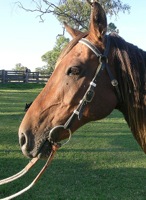Difference between revisions of "Bridle"
From Nordan Symposia
Jump to navigationJump to search (Created page with 'File:lighterstill.jpgright|frame ==Origin== [http://nordan.daynal.org/wiki/index.php?title=English#ca._1100-1500_.09THE_MIDDLE_ENGLISH_PERIOD Midd...') |
m (Text replacement - "http://" to "https://") |
||
| (One intermediate revision by the same user not shown) | |||
| Line 2: | Line 2: | ||
==Origin== | ==Origin== | ||
| − | [ | + | [https://nordan.daynal.org/wiki/index.php?title=English#ca._1100-1500_.09THE_MIDDLE_ENGLISH_PERIOD Middle English] ''bridel'', from [https://nordan.daynal.org/wiki/index.php?title=English#ca._600-1100.09THE_OLD_ENGLISH.2C_OR_ANGLO-SAXON_PERIOD Old English] ''brīdel''; akin to Old English ''bregdan'' to move quickly |
| − | *[ | + | *[https://en.wikipedia.org/wiki/12th_century before 12th Century] |
==Definitions== | ==Definitions== | ||
*1: the headgear with which a horse is [[governed]] and which carries a bit and reins | *1: the headgear with which a horse is [[governed]] and which carries a bit and reins | ||
| Line 9: | Line 9: | ||
*3: curb, restraint <set a bridle on his [[power]]> | *3: curb, restraint <set a bridle on his [[power]]> | ||
==Description== | ==Description== | ||
| − | A '''bridle''' is a piece of equipment used to direct a [ | + | A '''bridle''' is a piece of equipment used to direct a [https://en.wikipedia.org/wiki/Horse horse]. As defined in the [[Oxford English Dictionary]], the "bridle" includes both the headstall that holds a bit that goes in the mouth of a horse, and the reins that are attached to the bit. |
| − | Headgear without a bit that uses a noseband to [[control]] a horse is called a [ | + | Headgear without a bit that uses a noseband to [[control]] a horse is called a [https://en.wikipedia.org/wiki/Hackamore hackamore], or, in some areas, a [https://en.wikipedia.org/wiki/Bitless_bridle bitless bridle]. There are many different [[designs]] with many different name variations, but all use a noseband that is designed to exert [[pressure]] on [[sensitive]] areas of the animal's [[face]] to provide [[direction]] and [[control]].[https://en.wikipedia.org/wiki/Bridle] |
[[Category: General Reference]] | [[Category: General Reference]] | ||
Latest revision as of 23:41, 12 December 2020
Origin
Middle English bridel, from Old English brīdel; akin to Old English bregdan to move quickly
Definitions
- 1: the headgear with which a horse is governed and which carries a bit and reins
- 2: a length of line or cable attached to two parts of something to spread the force of a pull; especially : rigging on a kite for attaching line
- 3: curb, restraint <set a bridle on his power>
Description
A bridle is a piece of equipment used to direct a horse. As defined in the Oxford English Dictionary, the "bridle" includes both the headstall that holds a bit that goes in the mouth of a horse, and the reins that are attached to the bit.
Headgear without a bit that uses a noseband to control a horse is called a hackamore, or, in some areas, a bitless bridle. There are many different designs with many different name variations, but all use a noseband that is designed to exert pressure on sensitive areas of the animal's face to provide direction and control.[1]
